1956
Eureka (USA) Various professional cars
built on the Cadillac commercial chassis, like the examples below:
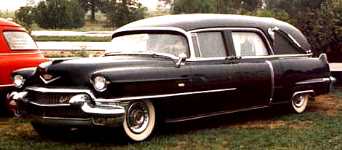
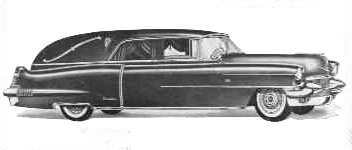 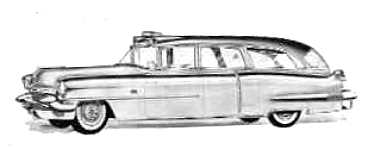
Eureka hearse and ambulance models
Hess & Eisenhardt (USA) stretched
convertible presidential parade cars (on Cadillac's regular "commercial"
chassisd?) dubbed Queen Mary II and Queen Elizabeth II. They
replaced two 1938 Cadillac V-16 parade cars nicknamed Queen Mary and Queen
Elizabeth. These cars [the 1956 models] were built and used during the Eisenhower,
Kennedy and Johnson administrations, remaining in service until 1968. Queen Elizabeth
spent some time in Paris before "she" was acquired by the late Charly de Pauw, a
Belgian collector; he claimed it was HIS car that was following the Kennedy Lincoln on
that fateful day in November 1963. When de Pauw died, his car was acquired by well-known
Belgian car collector, Ghislain Mahy, who exhibited the car in Belgium's national auto
museum, the Palais national de l'automobile. That's where I photographed it
in the eighties. In 1998, this car was sold, together with "Queen Elizabeth",
one of the former 1938 V-16 [now V-8] White House security cars (dark blue car #2), for a
reported $1.6 million. In April 2001 those cars was again offered for sale, this time in
the Vegas Auction venue of the Imperial Palace collection. "Queen Mary
II" is believed to be the 1956 White House security car that followed directly behind
the presidential Lincoln on that fateful day, November 22, 1963, when President Kennedy
was shot dead by one [or more?] assassins. Jack Tallman of Tallman Cadillac in Decatur, IL
was its owner. I was fortunate to be allowed to drive it when I visited Jack in Decatur
back in 1978.
"Queen
Elizabeth II"
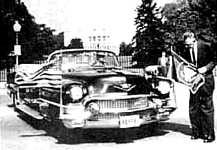 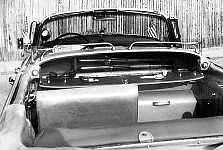
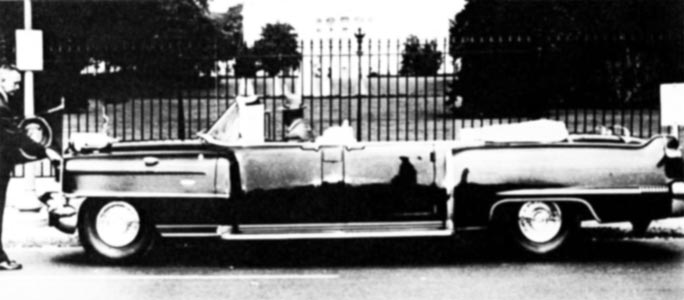
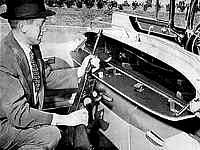 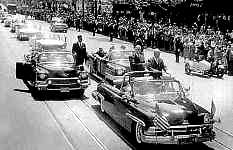
Above four photos: preparing for a mission (a)
top left: unfurling the flags (the one
with the presidential seal is on the right, front fender, (b) top right: weapons
all present?
(c) lower left: let's add a Tommy gun for good measure, (d) lower right: in active
service
behind the then presidential Lincoln (Eisenhower and General De Gaulle aboard).
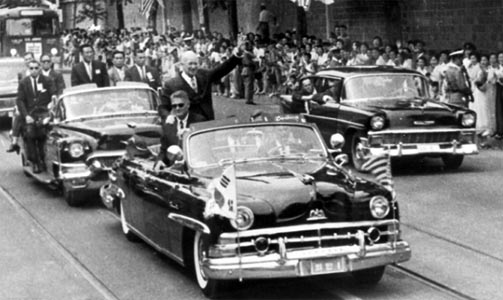
I believe the flag on the RH febder of
the President's Lincoln is that
of South Korea, I have not been able to determine the year or the venue
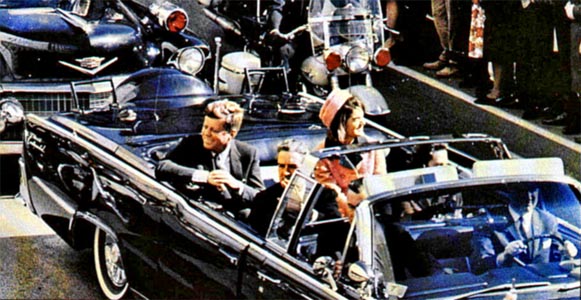
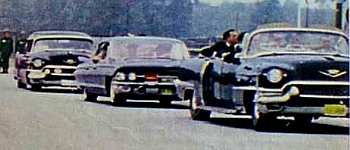
Above, Queen Elizabeth II on
a security mission in Berlin on June 26, 1963; this presumably was the
Paris car (car #1) that, later, found its way to Brussels; remember Kennedy's
famous words on that historic occasion:
Ich bin ein Berliner! [in other words, Guys, I'm a 'Berliner' too, or
I'm one of you]
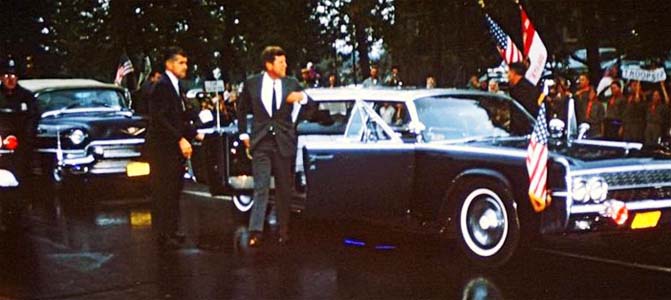
I don't recognise the venue, but the
car is there ... lurking in the background:
President Kennedy is seen alighting from the government Lincoln
Continental
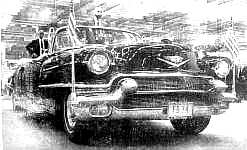
Poor quality photo (above - from newspaper) shows
"Queen Elizabeth II" on display
in the Belgian capital of Brussels, complete with dummy G-Men aboard
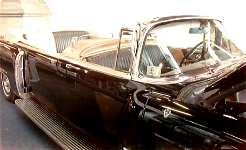 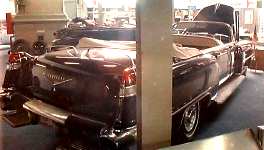
I took the above two snapshots in the Belgian Museum
in the eighties (pity about that pillar!)
[ Photos: © 1989, Yann
Saunders - Autoworld
Museum, Brussels].
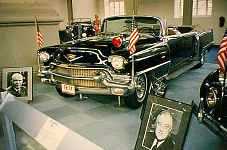
The second 1938 and 1956 White House security cars formerly on exhibit at the
National Auto Museum in Brussels, Belgium, were sold at auction, in
1998, for around $1,600,000
It is believed they were acquired for the Imperial Palace collection in
Las Vegas
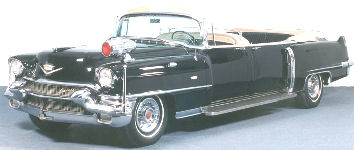 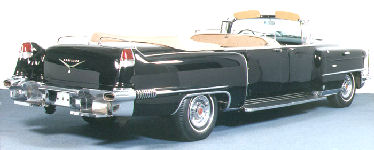
Photo: Internet [Imperial Palace, Las Vegas,
NV]
This is believed to be "Queen Elizabeth II", formerly owned by the late
Charly de Pauw
"Queen Mary
II"
Although early photos of one of these cars shows
it with the smaller, lower grab handles mounted at the A pillars [windshield frame], both
cars now have the larger, raised handles, as seen on the car used in the November
motorcade. The original grab handles fixed to the secondary cowl also were modified by
adding to the extremities of the existing handles an angled piece that faces outwards and
forward. Neither car was used in the film by Oliver Stone that recounted the Kennedy
assassination. So far as I can tell from the movie still (below), the car used was a
customized Series 75 limousine; the small fender lamps used to illuminate the
presidential standards were omitted; the combination siren and flashing red light on the
LH front fender were mounted too far astern and the doors were not made narrower to allow
for more standing room on the running boards; the movie car has also the small,
rectangular grab handles. Article in SSA 1981, p.12-13. Photo McC
p.317-318.
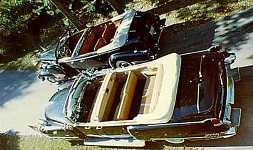 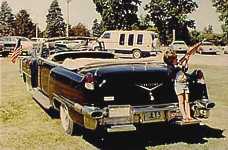
Two White House security cars in a single collection,
that of Jack Tallman, Decatur, IL.
Right: my son Jamie (aged 4 at the time), takes a shot at some bad guys
hiding in the trees!
Owned by Wayne Lensing, the car is currently (2005) on display at the Historic
Attractions Museum in Roscoe, IL
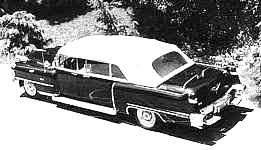 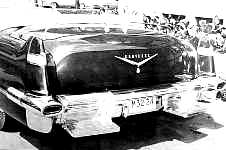
Photo left: rarely was the top ever put up, but it
was there in case of a sudden downpour. Photo, right:
close-up of the bumper mounted, fold-down step plates and the grab handles used by
the duty G-Men
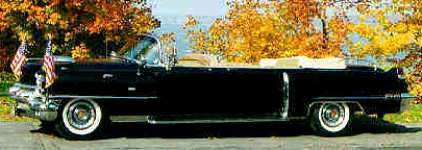
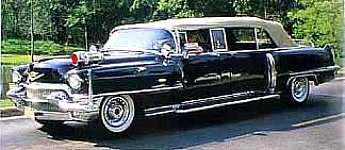 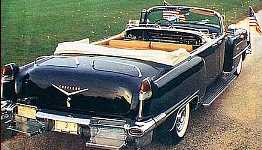

Preceding four photos of car #2: courtesy of Jack Tallman
Jack's car was in the tragic Dallas motorcade, in November, 1963
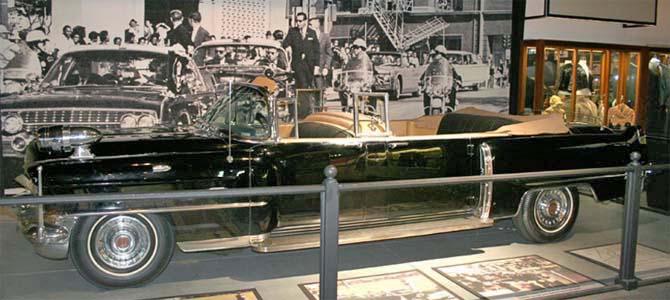
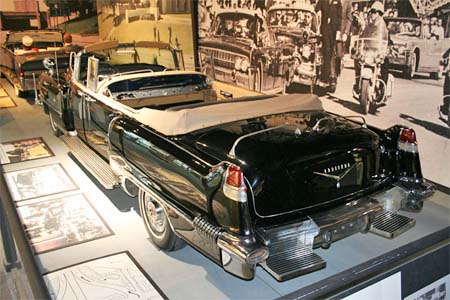
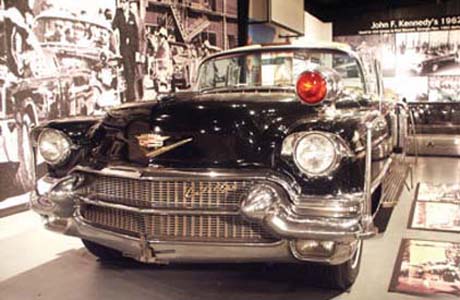
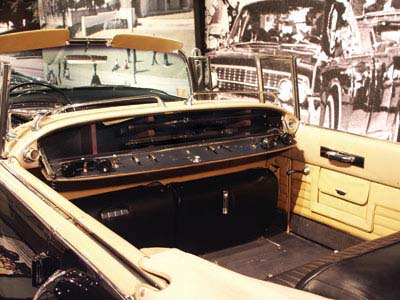
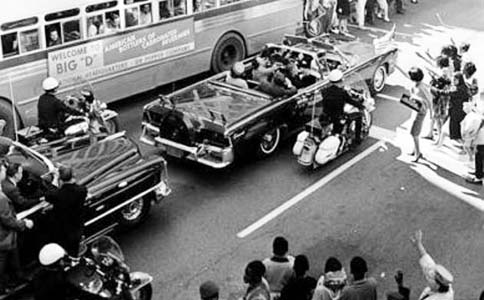
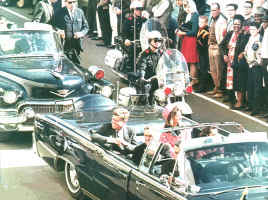 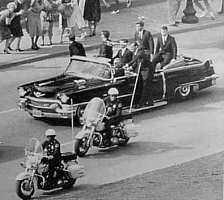
Dallas, TX, November 22, 1963, despite every
precaution taken, president Kennedy
is assassinated... [photo, left]. Right is a still from the movie Kennedy;
you will notice how the movie car is much shorter than the original and
the running boards are mounted outboard of the body sides
The
"Made for Movie" car
[ which I am guessing was converted from a stock Fleetwood 75 sedan ]
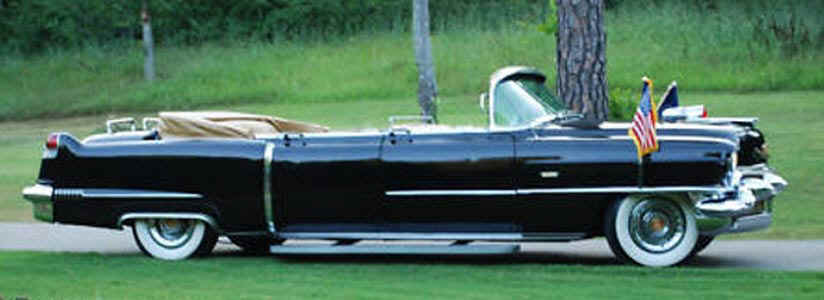
The extension panel that fits between the doors of
the original security cars is missing; it was joined by a solid cowl across the front seat
back that housed
a deep storage cabinet for rifles, hand guns and phone receivers; the rear
doors on the original cars were the "suicide" type, hinged on the "C"
pillars;
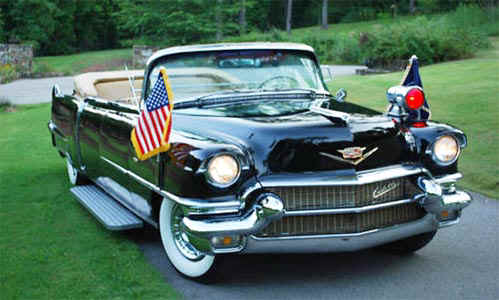 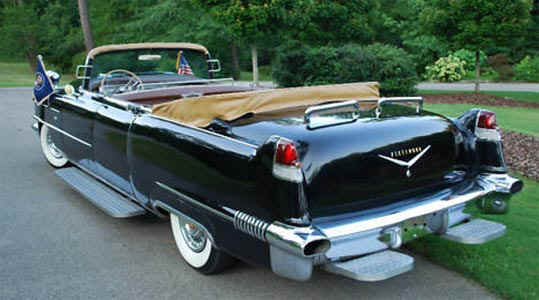
Here we see how far outboard the running boards are
mounted on the movie car; on the orignal cars, the doors were inset and narrower
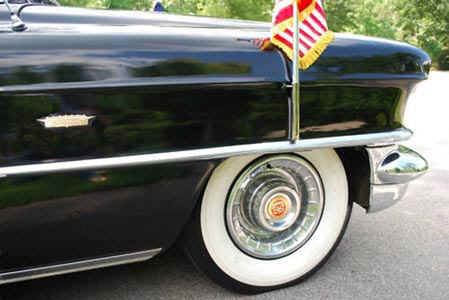 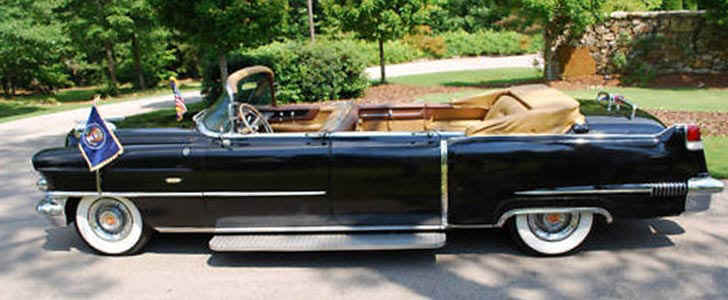
The flag staffs on the original cars are mounted on
the outer edge of the gull-wing front bumpers; on the movie car they are attached to
the fenders, level with the center of the wheel well
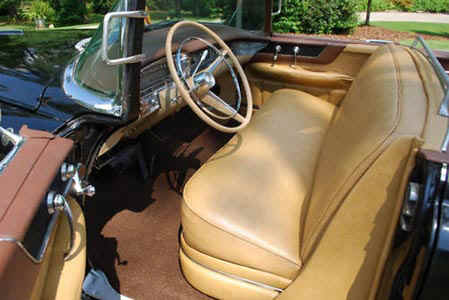 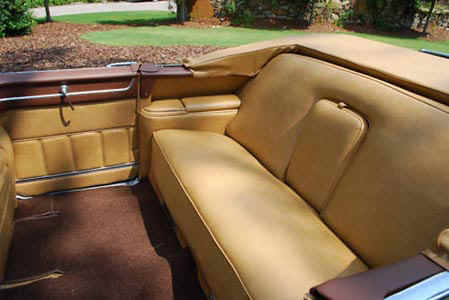
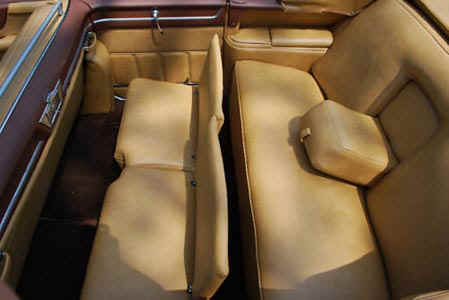
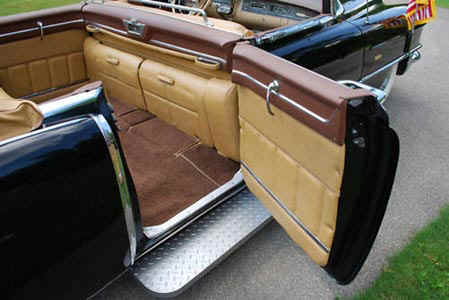 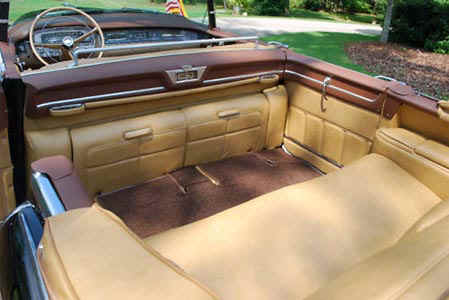
The cowl extension on the original cars gave more leg
room between the jump seats and the rear seat; the rear door panels
on the original cars had a long, horizontal pull handle as well as horizontal
piping and a large flap pocket decorated with the Cadillac crest;
on the original cars, there are twin grab handles across the division cowl (not a
single bar);
the back of the unopened jump seats are a plain design, unlike the biscuit
and button design on the movie car
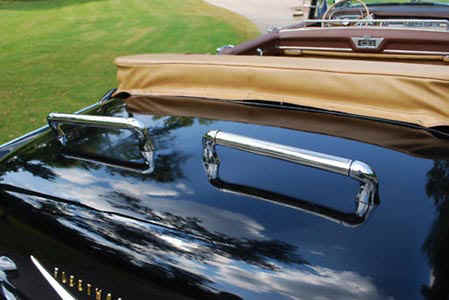 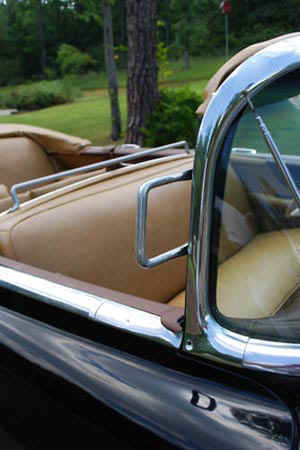 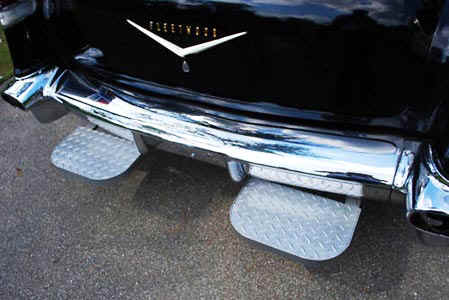
On the original cars, the trunk grab handles are
slimmer, longer and of one-piece construction;
also, the grab handles on the "A" pillars are curved upwards, level with
the top of the windshield frame;
the rear step plates (right) are striated, crosswise; they are not
rounded; they are the fold-away type;
the trunk lid inscription (right also) reads "CADILLAC" and not
"FLEETWOOD"
Hess & Eisenhardt (USA) Various custom
vehicles for the ambulance and funeral trades like the examples below:

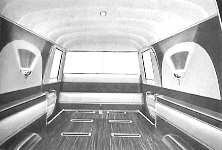 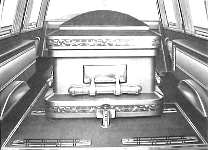 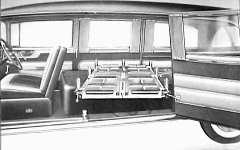
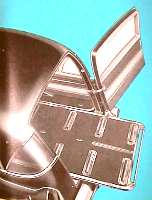 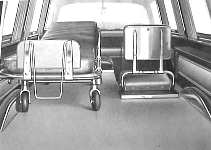 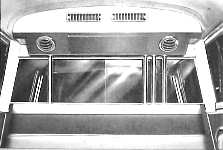

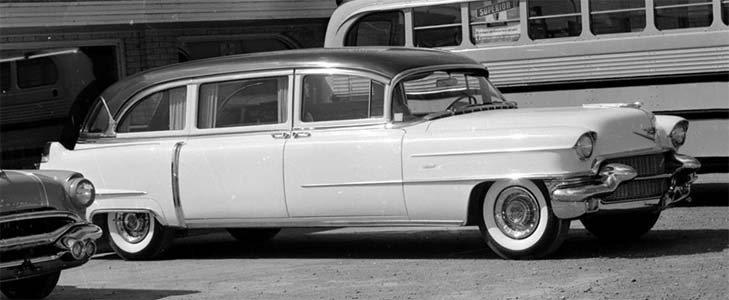
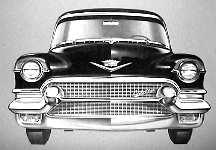 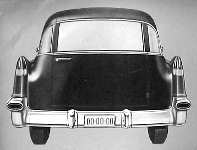

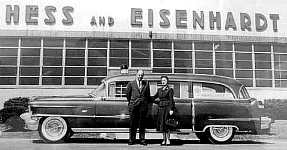 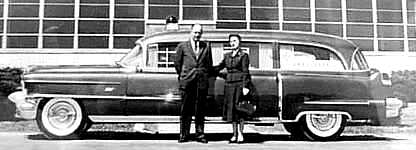
This combination hearse-ambulance was copied from a
photo in the collection of the
McSwain & Evans, funeral home in Newberry, SC, courtesy of the management
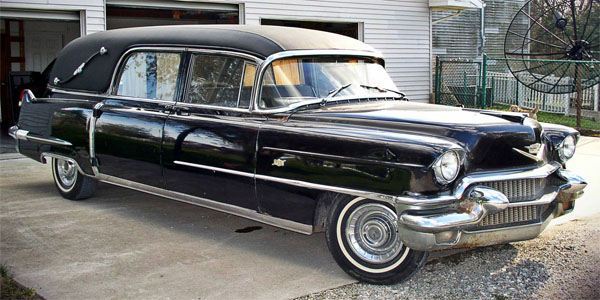
[ Photo: Professional Car Society ]
Hess & Eisenhardt (USA) Skyview
observation coach on the 158" wheelbase. Like the 1955 model, of which six were
built, these 1956 models also were delivered to the exclusive Broadmoor Hotel near Pike's
Peak, Colorado. All were painted Mandan Red and had Pecos beige upper body accents.
There were four large, transparent Plexiglas roof panels on the roof for
sightseeing in the scenic park around the hotel. One of these rare station wagons
was offered for sale at a Kruse auction in Scottsdale, AZ, in January 2001. Although bid
up to $53,000, it was not sold.
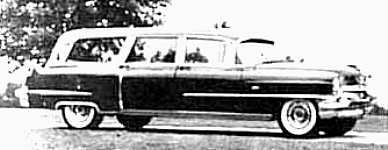
Hess & Eisenhardt (USA) This Custom
View Master with roof rack but no imitation wood paneling was photographed at a car
show in the mid-seventies by the late Gene Babow
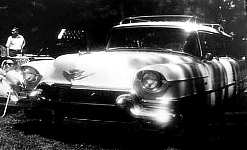 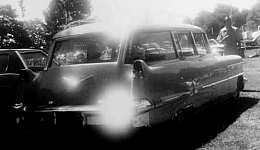
Hess & Eisenhardt Custom View Master
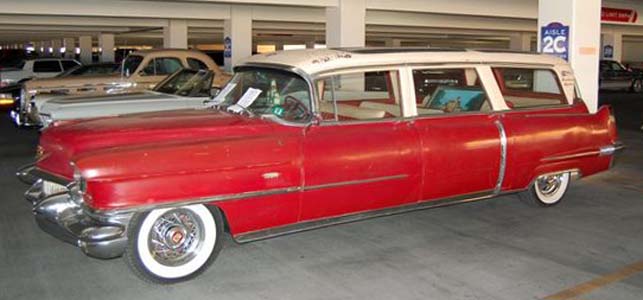
[ Photo:
© 2009 Jeffrey Hansen ]
Miller, A.J. (USA) various
vehicles for the funeral industry, like the landau coach below
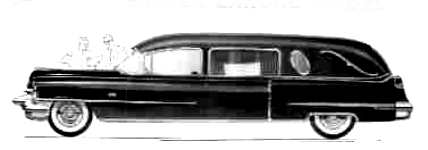
Miller landau hearse
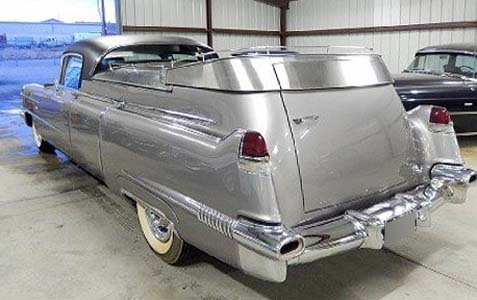
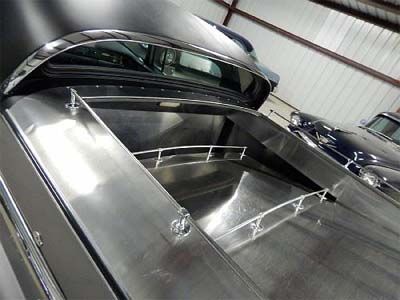
Meteor (USA) Various custom
vehicles for the ambulance and funeral trades like the examples below:
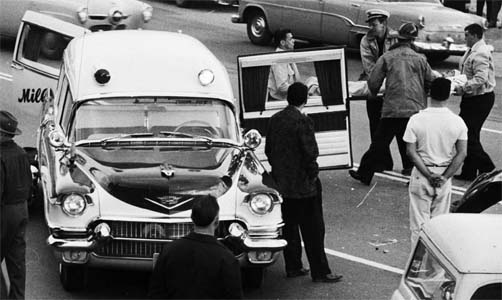
Hard at work ... in 1956?
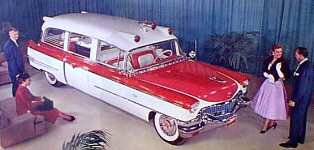 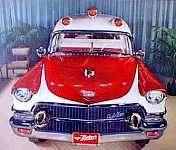
This model was built by the Meteor Motor Car Company
of Piqua, OH
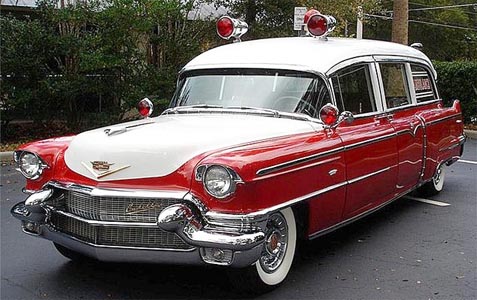
A rare and beautiful survivor
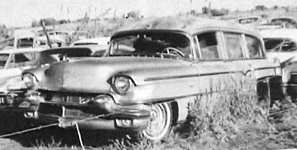 : :
This one was photographed a few years ago in a
junkyard:
could it be the above car???
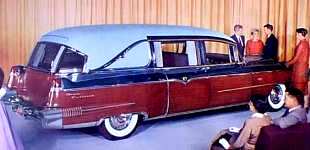 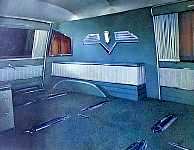
Above: the renowned Crestwood hearse
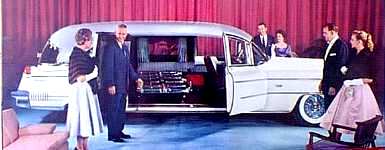 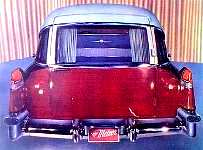
Above two photos, the Meteor side-service coach with
landau styling; the wrap-around
rear corner windows were standard on all Meteor cars except for
the Landau Traditional models and the Envoy flower car

Above, the popular Meteor
combination hearse-ambulance
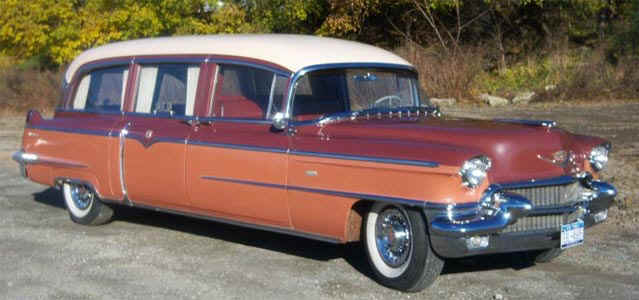 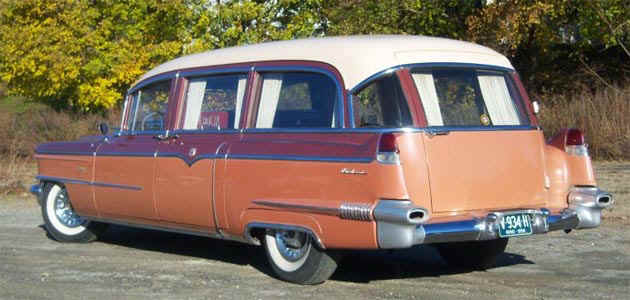
Above 2 images: a magnificent
survivor
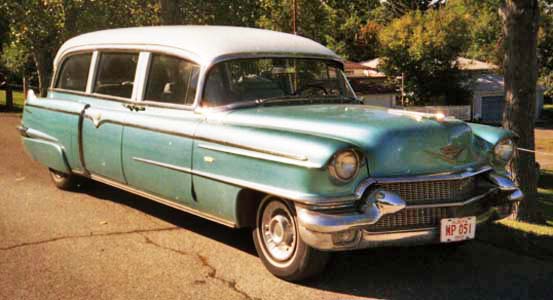
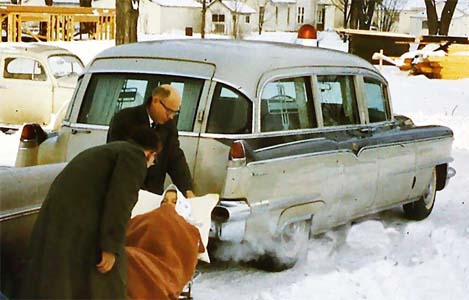
The odd black mark seen between the RH
front door & fender suggests these could be one and the same car;
possible?
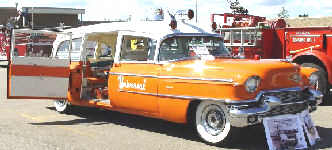
Converted
ambulance used as a prop by Universal Studios in California?
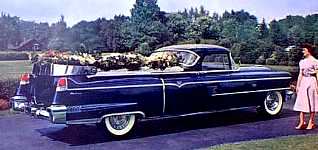
This flower car too is from the Meteor Motor Car
Company
S&S [Hess & Eisenhardt] (USA) Various commercial
vehicles including ambulances, flower cars and hearses such as the example below; these
are the renowned "S&S" models
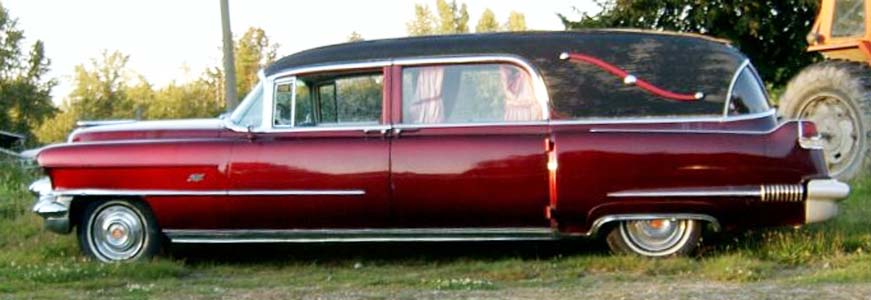
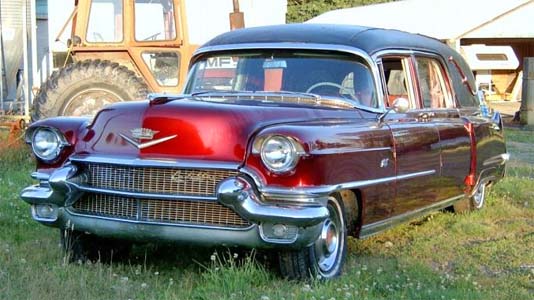
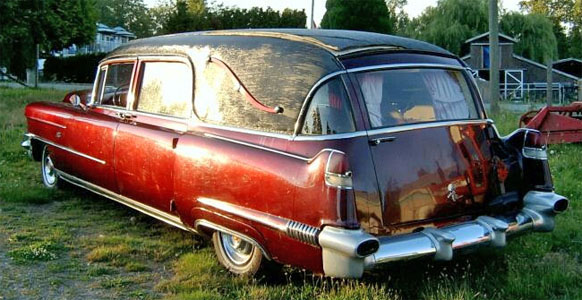
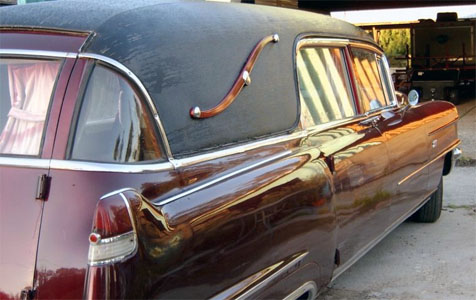
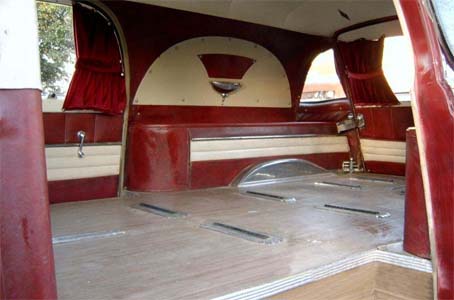
Superior (USA) various commercial vehicles
for the funeral and ambulance trades, like the examples below:
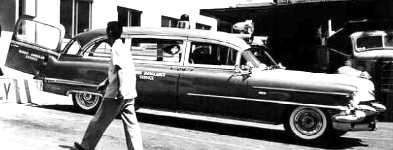
Above and below: Superior limousine ambulance, with
built-in, "tunnel" roof lights;
The car below appears to have done its time; it now awaits an enthusiastic restorer
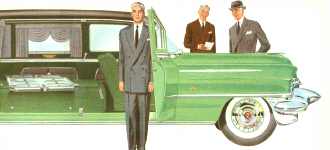
Here's a side-loading hearse from a
Superior product catalog of this year
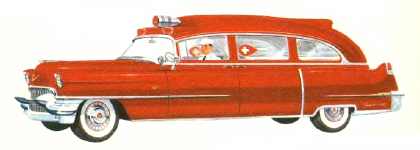
...and here's an ambulance from the same brochure
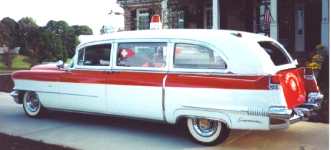 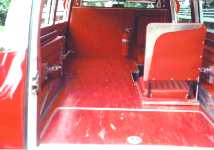
This survivor was offered for sale on Internet in
August, 2004
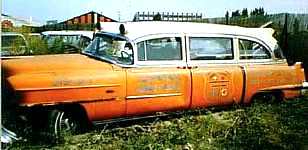
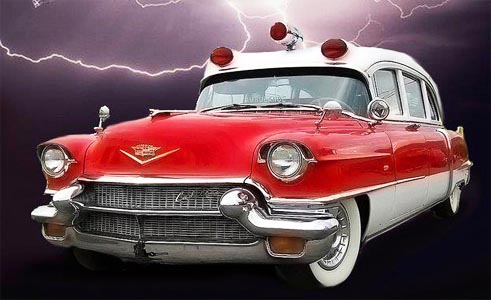
An "artsy" survivor - possibly from
Superior
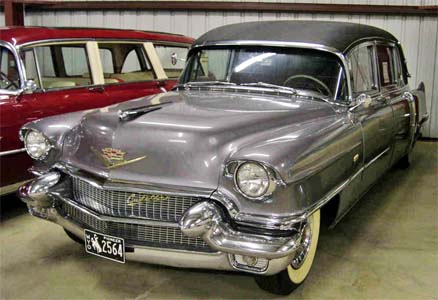
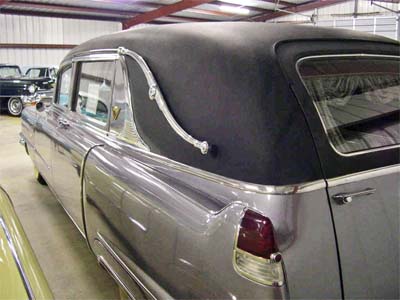
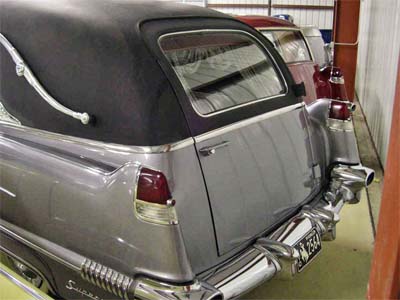
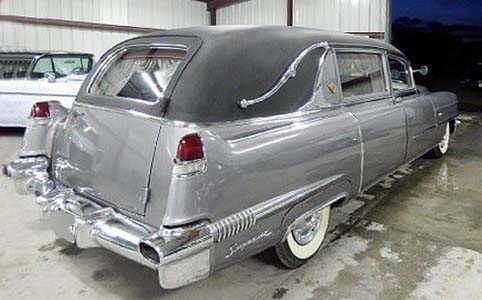
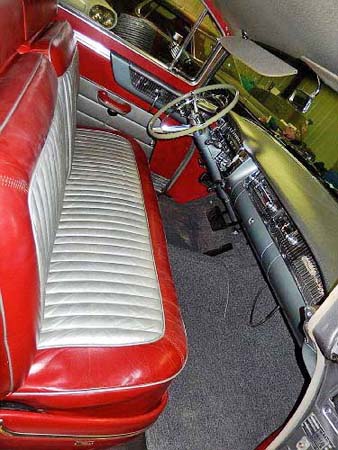
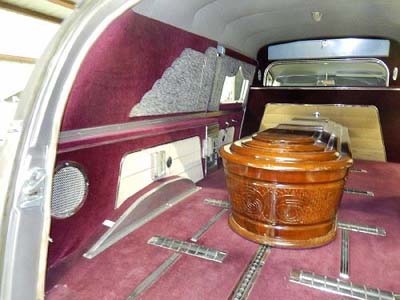
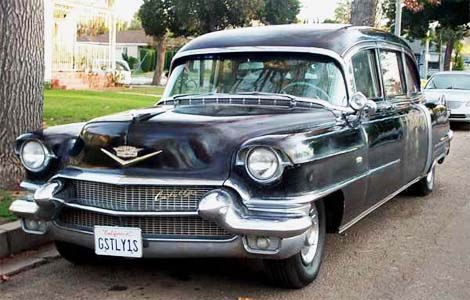
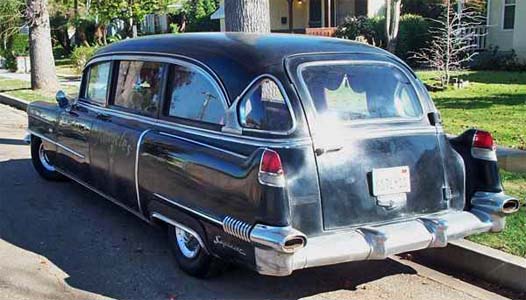
This survivor was used by a band to
transport their gear
[Unknown] (probably from
Europe) Fire truck conversion on 1956 Cadillac chassis
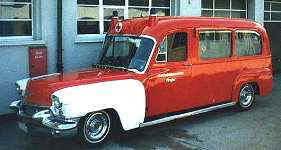
[Unknown] (USA?) Hi-Top
ambulance; maker unknown
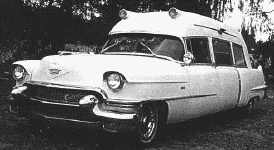
[ Image: Internet, 2008 ]
Visser [meaning
"Fisher", in Dutch] (Holland) Various commercial vehicles (hearses
and ambulances on regular or stretched Cadillac chassis, like this one from 1956. My
friend Dirk-Jan de Jong of Holland wrote: This one is built on a 1956 Cadillac
commercial chassis. At least one of the cars still exists and is (partly) restored by a
guy living near my parents. The construction is partly made from wood. Note the
non-standard windshield. At the start of the seventies it was over for the Cadillac
ambulance as regulations (and money supply) were tightened and a switch was made to the
(Chevy)van-based ambulances.
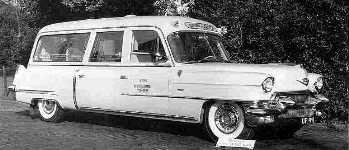
Visser built an entire new upper body, including the
windshield
[ Photo: "Ambulances in beeld (1945 - 1975)", courtesy Dirk-Jan De
Jong, Holland ]
|